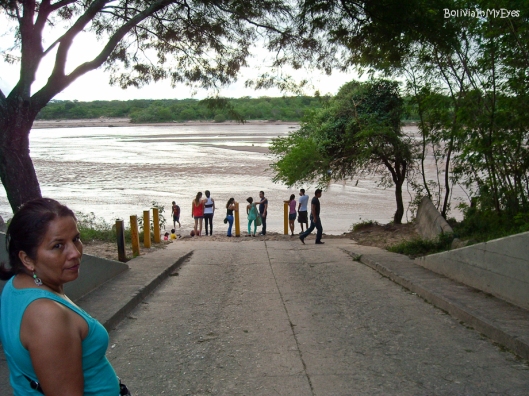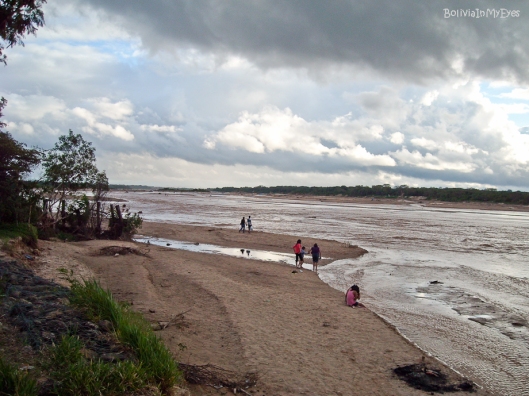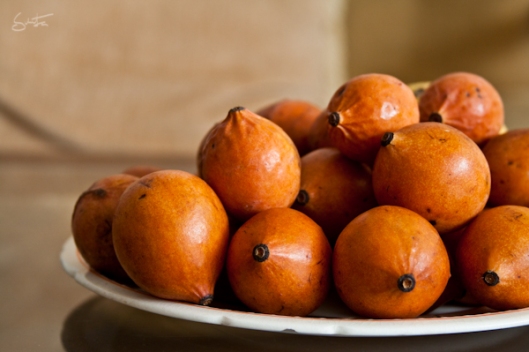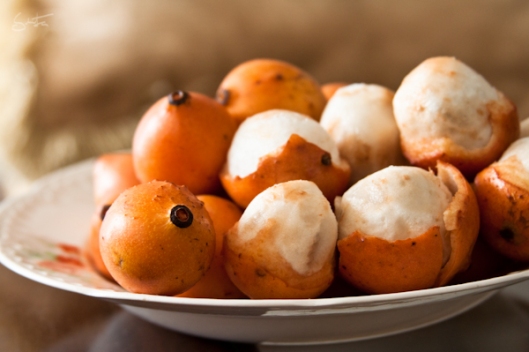Tarija, zwana ‘boliwijską Andaluzją’, to stolica boliwijskiego wina oraz narodowego spirytusu, odpowiednika naszej polskiej wódki czy włoskiej grappa – 40 % Singani. Boliwijskie wina nie są możne tak znane w Europie jak te z Chile czy Argentyny, tradycja ich produkcji przemysłowej liczy sobie bowiem dopiero pól wieku, ale być może z czasem się to zmieni? Region Tarija ma te przewagę nad sąsiadami, iż znajduje się na wysokości około 2.000 m n.p.m., a wino tam produkowane zawiera ponoć więcej antyoksydantów niż to produkowane na obszarach nizinnych. I według mnie, smakuje wyśmienicie!
Tarija, called the ‘Bolivian Andalucia’, is the capital of the Bolivian national wines and spirit – 40% Singani, which is the equivalent of our Polish vodka or Italian grappa. Bolivian wines may not be known in Europe as well as those from Chile and Argentina. The tradition of industrial production of wine has started only half a century ago, but maybe with time this will change? Tarija region has this the advantage over its neighbors, that it is located at an altitude of about 2,000 meters above sea level, and the wine produced there reportedly contains more antioxidants than that produced in lowland areas. And in my opinion, it also tastes great!
Si vino a Tarija y no bebe vino, entonces, porque vino?*
Najlepszym sposobem na poznanie okolicznych winnic i zapoznanie się z produkcja wina oraz tajnikami jego degustacji, jest wykupienie wycieczki w jednej z wielu agencji turystycznych. My wybraliśmy się na objazd z ‘Bus Turistico‘, który odjeżdża codziennie z głównego skweru (Plaza Luis de Fuentes) o godzinie 8.30 i 14.30. Jeżeli zbierze się mniej osób, zabiera ich jeep.
The best way to discover the surrounding vineyards and familiarize yourself with the ways of wine production and tasting it, is to buy a tour in one of the many tourist agencies. We went on a tour with ‘Bus Turistico“, which departs daily from the main square (Plaza Luis de Fuentes) at 8.30 and 14.30. If they are fewer people (in low season), they use the jeep instead.

Ruta de Vino y Singani de Altura składa się z trzech tras, z których każda kosztuje około 130 bs. od osoby i trwa mniej więcej 4 godziny. Jeżeli ktoś ma czas i ochotę, możne wykupić wszystkie trzy wycieczki w cenie 300 bs. od osoby, co tez uczyniliśmy my sami. * Najlepiej jest się wybrać do Tarija podczas boliwijskiego lata (grudzień – marzec), kiedy winnice są zielone, a winne krzewy uginają się pod ciężarem winogron, ale degustować można przez cały rok:)
‘Ruta de Vino y Singani de Altura’ consists of three routes, each of which costs about 130 bs. per person and takes about four hours. If the time permits, then you can purchase all three trips for the price of 300 bs. per person, which we did ourselves. * It is best to come to Tarija in the Bolivian summer (December – March), when the vineyards are green, and the vines are bending under the weight of the grapes, but you can taste the wine all year round :)

Trasa 1: wina przemyslowe i tradycyjne/ industrial and tradicional wines
* Kohlberg: winiarnia/ winery
Kohlberg to najbardziej znane wino boliwijskie, mające najdłuższą, bo ponad 50-letnia tradycje produkcji na skale przemysłową. Nazwa pochodzi od nazwiska rodowego, jak pewnie się domyśliliście, niemieckiego. Senior rodu, inżynier, przybył do Boliwii jeszcze przed wojna, osiedlając się w Tarija, ale winiarnie założył jego syn, Don Julio. Ciekawostką jest, a nie dowiedzieliśmy się tego podczas wycieczki, ze w 2009 roku w Bułgarii, w butelkach wina Kohlberg znaleziono kokainę w stanie ciekłym!Na szczęście, incydent, nie zaszkodził reputacji winiarni, wino nie bylo eksportowane przez producenta.
Kohlberg, is the best known and the oldest winary in Bolivia having more than 50-years long tradition of manufacturing on an industrial scale. The name is derived from the German surname, as you probably guessed, of the owners family. The Senior, an engineer, came to Bolivia before the war settling in Tarija, but winery was founded by his son, Don Julio. Interestingly, and we did not learn it during the tour, in 2009 in Bulgaria the customs found the cocaine in liquid form in Kohlberg’s bottles of wine! Fortunately, the incident did not harm the reputation of the winery, because the wine wasn’t shipped to Europe by the producent.
* Kohlberg: Winnice i degustacja wina/ vineyards + wine tasting
Z fabryki udajemy sie do domu rodzinnego Kohlbergow poza granicami miasta w Dolinie Santa Ana. Tam po raz pierwszy degustujemy wino (szkoda, ze tylko stołowe, które w sklepie kupimy za około 2€) oraz przepyszne, produkowane lokalnie, sery i szynkę. Przez chwile obszczekuje nasza grupę moja imienniczka – wyżeł niemiecki, Danka. Ładna, prawda?:)
The tour goes from the factory to Kohlberg family home in the countryside of the Valley of Santa Ana. There, for the first time, we can taste the wine (what a pity that only table one that you can buy in the store for about 2 €!) and delicious, locally produced cheese and ham. For a moment we are barked at by a dog, named like myself – Danka. Lovely, is she not?:)

* Valle Concepcion
Piękne okolice, w porze suchej niestety trochę… suche i ziemiste, ale i tak urocze.
Beautiful surroundings, in the dry season unfortunately … a little dry and earthy, but still charming.

* La Tablada: Degustacja win ‘artesanales’ / artesan wine tasting
Zatrzymujemy się na chwilę w malutkiej miejscowości, gdzie mieści się sklep monopolowy ‘Las Duelas’ z winami i innymi alkoholami lokalnych producentów. Tu mamy kolejna degustację, tym razem wina deserowego oraz zakupujemy… paczkę suszonych owoców.
We stop for a while in the tiny village, visiting a store ‘Las Duelas’ which is selling wine and liquor from local producers. Here we have another wine tasting, this time sweet dessert one … and we buy a pack of dried fruit.
* Canon del Angosto
W drodze do ostatniego punktu programu, zatrzymujemy się kolo mostu, z którego można podziwiać Kanion del Agosto, podobno jedną z największych atrakcji regionu. Podobno, bo sam widok nie sprawia na nas piorunującego wrażenia. Co innego byłoby się przejść po jego dnie, a niektóre agencje podobno oferują takie atrakcje.
On the way to the last stop, we pass by the bridge from where you can admire the Canyon del Agosto, reportedly one of the biggest attractions of the region. Apparently, because the mere sight does not impress us at all. It would be interesting however to walk at the bottom of and some agencies reportedly offer such attractions.

* Casa Vieja: degustacja win ‘paternos’ (produkowanych sposobem tradycyjnym)/ tasting of wines ‘paternos’ (produced in traditional way)
W końcu zatrzymujemy się w Uriondo, malutkim miasteczku, które zachowało klimat kolonialny, gdzie w najstarszym budynku (CasaVieja), zbudowanym w sposób tradycyjny z gliny i drewna, przechodzimy do ostatniej degustacji. Lokalnym zwyczajem, pijemy rożne wina (niestety tylko słodkie) z jednego kieliszka, a ostatnia osoba musi wychylić kielicha do ostatniej kropli. Na szczęście, my byliśmy pierwsi w kolejce, ale turysta z Argentyny całkiem nieźle sobie poradził, nawet z ostatnim kieliszkiem czystego Singani!
In the end we stopped in Valle de Concepción, in a small town of Uriondo with preserved colonial atmosphere, and its oldest building Casa Vieja, built in the traditional manner with clay and wood. By local custom, the whole group was offerend anothe wine testing, drinking different wines (unfortunately only sweet ones) from one glass, and the last person has to drink it up to the last drop. Fortunately, we were first in the queue, but a tourist from Argentina did pretty well, even after finishing the full glass of pure Singani!

Casa Vieja
W ‘starej chacie’ zjedliśmy typowa dla regionu Tarija potrawę, chancho a la cruz, czyli prosiaka pieczonego na palu przy ognisku. Trochę drogo, ale smacznie. A potem, wyruszyliśmy na mały spacer po miasteczku.
At Casa Vieja we ate typical Tarija’s dish, chancho a la cruz – roasted suckling pig. A little pricey, but delicious. And then, we went for a little walk around the town.

Trasa 2: Wino i Singani/ wine and Singani
Te wycieczkę polecam szczególnie tym, którzy nastawiają się na profesjonalną degustację i chcą się czegoś nauczyć.
This trip I recommend especially to those who want to experience the professional wine tasting and learn something about wine.
*Casa Real: destylernia Singani + degustacja/ Casa Real: distillery of Singani + tasting
Singani to rodzaj brandy destylowanej z wytłoczyn winogron Muscatu z Alexandrii, produkowanej tylko w boliwijskich Andach i uważanej za narodowy napój alkoholowy Boliwii i jej dziedzictwo kulturowe. Singani jest produkowane od XVI wieku, od przybycia Hiszpanow do Ameryki Południowej i podobno zawdziecza swoja nazwe prekolimbijskiej miejscowosci, w poblizu misji, ktora jako pierwsza destylkowala ten trunek.
Singani is a type of brandy distilled from Muscat of Alexandria grapes, which is produced only in the Bolivian Andes and is considered to be a national liquor of Bolivia and its cultural heritage. Singani has been produced since the sixteenth century, shortly after the arrival of the Spaniards in South America. Singani reportedly was named after pre-Columbian village, near the Mission, where the liquor was first destiled.

Ze względu na produkcję winogron w ekstremalnym klimacie na dużej wysokości, Singani ma wyraźny profil smakowy, osiągnięty bez procesu starzenia, podobnie jak tequila. Trunek jest przezroczysty. Poza tym, Singani nie zawiera siarczanów, barwników, wzmacniaczy smaku, które pojawiają się w innych podobnych alkoholach.
Due to the production of grapes in extreme climate at high altitudes, Singani has a pronounced flavor profile, achieved without the aging process, like tequila. Besides, Singani does not contain sulphate, dyes, flavor enhancers that appear in other similar alcohols.

Od momentu powstania trunku, Singani było pijane na czysto, i dopiero w XIX wieku ukształtowała się kultura koktajli. Wyjątkiem jestsucumbé, koktajl górników z Potosi, którzy od 1608 roku zaczęli mieszać Singani z gorącym mlekiem i przyprawami. Nazwa tego pierwszego znanego koktajlu Singani prawdopodobnie jest pochodzenia afrykańskiego, bo jak pamiętacie, hiszpańscy konkwistadorzy sprowadzali niewolników z Afryki do pracy w kopalniach srebra Cerro Rico.
Since its beginnings, Singani was drunk pure, and only in the nineteenth century the culture of cocktails emerged. The exception is sucumbé, cocktail made by the miners of Potosi, who in 1608 Singani began to mix Singani with hot milk and spices. The name of the first known cocktail using thi liquor is likely to be of African origin, because as you may recall, the Spanish conquistadores imported slaves from Africa to work in the silver mines of Cerro Rico.

W XIX wieku, kolejowi inżynierowie z Wielkiej Brytanii i Ameryki, z powodu braku dżinu, zaczęli mieszać Singani z piwem imbirowym i tak powstał, dziś najpopularniejszy koktajl Singani – Chuflay. Anglicy nazwali koktail ‘shoofly’ od terminu określającego tymczasowa linie kolejowa, a Boliwijczycy, którzy nie umieli tego wymawiać przekręcili nazwę po swojemu:)
In the nineteenth century, the railway engineers from Britain and America building the rail in Bolivia due to lack of their favourite ‘gin’, began to stir Singani with ginger beer, inventing today’s most popular cocktail Singani – Chuflay. The English actually called this cocktail ‘Shoofly’ from the language term used for a temporary railway line, and the Bolivians, who could not pronounce the name, twisted it their way :)

Nigdy nie lubiłam tego mocnego alkoholu, bowiem zawsze próbowałam go na czysto, ale po degustacji w Casa Real, gdzie podano nam go w formie drinka Chuflay właśnie, z ginger ale, lodem i plasterkiem cytryny, bardzo mi zasmakował. A jeszcze lepiej smakuje z salteña, którą nam zaserwowano. W sklepiku Casa Real zakupiliśmy butelkę pierwszego w historii dlugo lezakujacego, bo 15 lat Singani – DonLucho. Jeszcze jej nie otworzyliśmy, bo aż szkoda:)
I’ve never liked this strong alcohol, as I’ve always tried it pure, but after tasting it as chuflay with ginger ale, ice and a slice of lemon at Casa Real, I was pleasntly surprised. And it even better tastes with salteña, which was also served. In the shop we bought a bottle of Casa Real’s first ever long matured for 15 years Singani – Don Lucho. We haven’t open it yet :)
* Singani destylowane jest również w innych rejonach Boliwii (tylko wysokogórskich!), ale większość winogron pochodzi z rejonu Tarija.
* Singani is also distilled in other regions of Bolivia (only high-altitude!), but most of the grapes come from the region of Tarija.

* Campos de Solana: winiarnia + degustacja/ Campos de Solana: winery + tasting
To druga co do wielkości winnica/winiarnia Boliwii i osobiście uważam, że najlepsza (obok Aranjuez, której zwiedzac niestety nie można). Po krótkiej lekcji produkcji wina, przeszliśmy do degustacji, profesjonalnie poprowadzonej przez pracownice Campos de Solana, która przekonała nas do zakupu jednego z najdroższych, ale również najlepszych win tej winnicy. Polecam, choć kosztuje ponad 20€ za butelkę.
This is the second largest vineyard / winery in Bolivia and personally I think that the best. After a short lesson of wine- making, we moved to the tasting, professionally led by a worker of Campos de Solana, who convinced us to buy one of the most expensive but also the best wine of the winery. I would recommend it, although it costs more than € 20 per bottle.

* San Bernanrdo: winnica + degustacja/ winery +tasting
Poranek zakończyliśmy w malej, prywatnej winnicy, która powoli przekształca się również w ośrodek eko-turystyczny, gdzie zostaliśmy przywitani przez samego właściciela, człowieka wielkiej wiedzy na temat wina. Degustacja tym razem obejmowała nie tylko bardzo dobre wino, które jeszcze nie zdążyło dostać etykiety, ale również grona winogron zmacerowane w Singani! Jeżeli powrócimy kiedyś do Tarija, to chcielibyśmy zatrzymać się w tym właśnie miejscu – nie tylko pięknym i spokojnym, ale również posiadającym białego konia:)
The morning ended in a small, private vineyard, which is slowly transforming itself into the eco-tourist resort, where we were greeted by the owner, a man of great knowledge about wine. Tasting this time included not only a very good wine that had not yet had time to get labeled, but also the grapes macerated in Singani! If we return someday to Tarija, we would like to stay in this place – not only beautiful and quiet, but also a home to a white horse :)

Jak widzicie, wycieczka po winnej stolicy Boliwii jest bardzo ciekawa, a przy okazji można zobaczyć codzienne życie tej krainy. To, czy i ile informacji przyswoimy sobie podczas degustacji zależy od naszej pamięci, umiejętności słuchania i rozumienia języka hiszpańskiego (nasza agencja nie oferowała tłumacza) oraz zainteresowania tematem. Ja niestety do dziś nie orientuje się w różnicy pomiędzy poszczególnymi gatunkami gron i win, które się z nich produkuje, ale zamierzam się dokształcić. Bo wino, szczególnie to boliwijskie z Tarija, bardzo polubiłam.
As you can see, the tour around the wine capital of Bolivia is very interesting and it’s a great way to see the daily life of people living here. How much information do you get during the tasting depends on your memory, ability to listen and understand Spanish (our agency did not offer an interpreter), and interest in the topic. Unfortunately, I still do not know the difference between the various types of grapes and wines, but I’m going to educate myself further. Because I like wine a lot, especially Bolivian one. From Tarija.
- Valle de Concepcion
* Jak głosi stare tarijeńskie przysłowie: ‘Jeżeli przybyłeś do Tarija i nie pijesz wina, to dlaczego tu przyjechałeś?’. Nie ma mocnych, trzeba pić;)
* The old Tarija’s proverb says: ‘If you came to Tarija and don’t drink wine, then why did you come here?’.


















































































